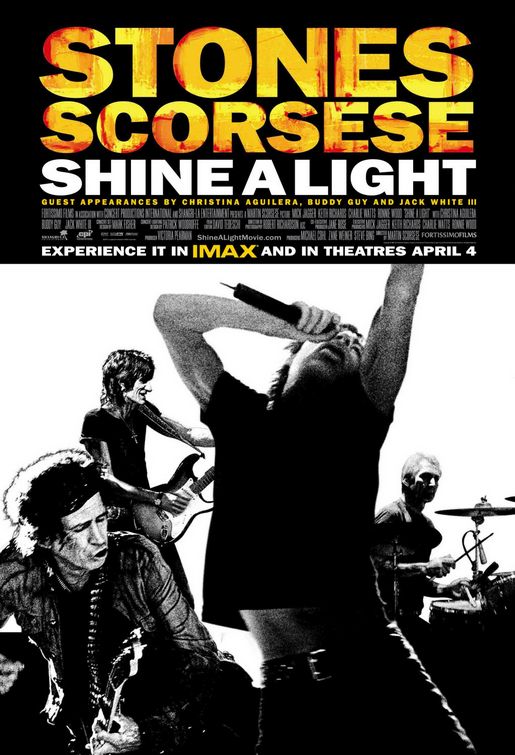
Longevity in the arts can be a double-edge sword. Artists no doubt appreciate having long careers in the endeavors they love, but it must be aggravating when they inevitably and unfairly have new material judged in comparison to the best works of their careers rather than on its own merits.
This certainly happens to the Rolling Stones and director Martin Scorsese, two legends in their respective fields, who haven’t come close in recent years to the consistent creative heights they previously achieved. It’s a tough position for anyone to argue anything they have released since the former’s Some Girls (1978) and the latter’s Goodfellas (1990) have earned similar praise and acclaim. (No doubt some will bring up Scorsese’s Oscar for The Departed, but that was in essence a lifetime achievement award and does more to reinforce the claim above because the film is flawed.) If there is any aggravation on their parts, you wouldn’t know it since they don’t shy away from their résumés and almost invite comparisons as their collaboration on Shine A Light, a concert IMAX film directed by Scorsese during the Stones’ 2006 A Bigger Bang tour, brings to mind historically significant concert films they have each made.
Gimme Shelter documented the Stones 1969 U.S. tour, which concluded with their headlining the infamous Altamont Speedway Free Festival, an event many point to as the cultural end of the “spirit of the 1960s.” Scorsese’s The Last Waltz was a star-studded swansong as the Band bid farewell with a little help from their friends at San Francisco’s Winterland Ballroom on Thanksgiving, November 25, 1976. Unless Shine A Light has recorded the last Stones tour, it will not feature an end of era like those earlier films, yet it still does a great job capturing this particular time in the band’s history.
Over the course of two nights at the Beacon Theatre in Manhattan, New York, the Rolling Stones along with their backing musicians and vocalists delivered a hit-packed, vibrant show that should put to shame any detractors fixated on their age. Mick Jagger was as active and engaged a front man as anyone a third his age. Charlie Watts was as competent and consistent as you would ever want any drummer to be. Ronnie Wood sounded good, especially when he played slide guitar.
Keith Richards was the only unpredictable factor. You never knew if he would recreate the magic or sound sloppier than some kid just learning the tune in his garage. Fantastic when he was given the mike, backed only by Charlie and Ronnie on “You Got The Silver,” but then during “Far Away Eyes,” he screwed up lyrics and laughed about it, earning a quick, evil glare from Mick, yet there’s something about those unpolished moments. In an odd way, it completes the package that is both the Stones and rock ‘n’ roll.
Besides, it’s not like Mick didn’t have his own gaffes. The absolute worst part of the entire performance was his singing the “woo woo” from “Sympathy for the Devil.” He sounds absolutely horrible delivering it so high pitched. It’s so bad it’s hard to believe he’s never heard it back or that Keith or Charlie hasn’t pulled him aside to stop him.
During the film, the Stones are joined by guests Jack White on “Loving Cup,” Christina Aguilera on “Live With Me,” and show-stealer Buddy Guy on “Champagne and Reefer,” who is so good that not only does he outshine Keith and Mick, who sounds great on the harmonica, but you want to follow Buddy when he leaves.
The band makes cuts for unexplained reasons so the songs may not be as you remember them. During “Some Girls,” it appears black girls no longer “want to fuck all night,” but the verse’s removal can’t be political correctness, as Mick still listens “to gospel music on the colored radio station” on “Far Away Eyes,” or puritanical, as the female he’s singing to can still “make a dead man cum” on “Start Me Up.” “Sympathy for the Devil” loses its third verse that asks, “Who killed the Kennedys?” which is understandable since at least one of these shows was a benefit for the Bill Clinton Foundation.
Anyone could just turn on the cameras, stand back, and let the Stones do their thing, but Scorsese improves on the viewing of the performance as he adds his precision to the Stones’ chaos. The cameras are in the right places and combined with purposeful editing, they capture the band up close for the viewer to see. Current music video directors and editors could learn a lot from watching this film’s structure.
Scorsese also brings along a historical perspective. With access to the archives, he presents clips of the band members and shows how they have grown over the years while most of the unimaginative journalists stayed the same. We see Mick after two years in the band to a current-day Keith and the common thread is that there is no plan. They’ll stop when the Rolling Stones stop being what they want it to be.
Scorsese almost becomes his worst enemy, as all this old footage combined with the 15-minute behind-the-scenes featurette that shows the band rehearsing reveals a much more interesting film was possible. Everyone knows the Stones on stage, but the scenes of the band at rest as regular people are much more fascinating. They seemed much happier plunking out obscure blues tunes together on a bare stage rather than cranking out one of their classic songs to adoring fans. For everyone’s sake, I hope a film of the Stones at rest will be made.
The extras also include material from the concerts not shown in theaters: “Undercover Of The Night,” “I’m Free,” Keith singing “Little T&A,” and a performance of “Paint It Black” that is so good it’s surprising that it got cut.
Fans of the Stones will get satisfaction from the Shine A Light DVD.